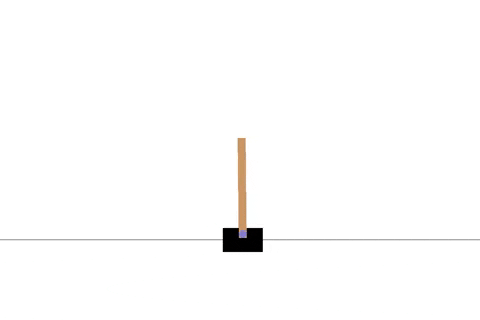演員-評論家方法
作者: Apoorv Nandan
建立日期 2020/05/13
上次修改日期 2024/02/22
說明: 在 CartPole 環境中實作演員-評論家方法。
簡介
此腳本展示在 CartPole-V0 環境中實作演員-評論家方法。
演員-評論家方法
當 Agent 採取行動並在環境中移動時,它會學習將觀察到的環境狀態映射到兩個可能的輸出
- 建議行動:行動空間中每個行動的機率值。Agent 中負責此輸出的部分稱為演員。
- 未來預估獎勵:預期未來收到的所有獎勵總和。Agent 中負責此輸出的部分是評論家。
演員和評論家學習執行其任務,使演員建議的行動最大化獎勵。
CartPole-V0
桿子連接到放置在無摩擦軌道上的車子上。Agent 必須施力移動車子。每次桿子保持直立時,Agent 都會獲得獎勵。因此,Agent 必須學習防止桿子倒下。
參考文獻
設定
import os
os.environ["KERAS_BACKEND"] = "tensorflow"
import gym
import numpy as np
import keras
from keras import ops
from keras import layers
import tensorflow as tf
# Configuration parameters for the whole setup
seed = 42
gamma = 0.99 # Discount factor for past rewards
max_steps_per_episode = 10000
# Adding `render_mode='human'` will show the attempts of the agent
env = gym.make("CartPole-v0") # Create the environment
env.reset(seed=seed)
eps = np.finfo(np.float32).eps.item() # Smallest number such that 1.0 + eps != 1.0
實作演員-評論家網路
此網路學習兩個函數
- 演員:這將環境狀態作為輸入,並傳回其行動空間中每個行動的機率值。
- 評論家:這將環境狀態作為輸入,並傳回未來總獎勵的估計值。
在我們的實作中,它們共享初始層。
num_inputs = 4
num_actions = 2
num_hidden = 128
inputs = layers.Input(shape=(num_inputs,))
common = layers.Dense(num_hidden, activation="relu")(inputs)
action = layers.Dense(num_actions, activation="softmax")(common)
critic = layers.Dense(1)(common)
model = keras.Model(inputs=inputs, outputs=[action, critic])
訓練
optimizer = keras.optimizers.Adam(learning_rate=0.01)
huber_loss = keras.losses.Huber()
action_probs_history = []
critic_value_history = []
rewards_history = []
running_reward = 0
episode_count = 0
while True: # Run until solved
state = env.reset()[0]
episode_reward = 0
with tf.GradientTape() as tape:
for timestep in range(1, max_steps_per_episode):
state = ops.convert_to_tensor(state)
state = ops.expand_dims(state, 0)
# Predict action probabilities and estimated future rewards
# from environment state
action_probs, critic_value = model(state)
critic_value_history.append(critic_value[0, 0])
# Sample action from action probability distribution
action = np.random.choice(num_actions, p=np.squeeze(action_probs))
action_probs_history.append(ops.log(action_probs[0, action]))
# Apply the sampled action in our environment
state, reward, done, *_ = env.step(action)
rewards_history.append(reward)
episode_reward += reward
if done:
break
# Update running reward to check condition for solving
running_reward = 0.05 * episode_reward + (1 - 0.05) * running_reward
# Calculate expected value from rewards
# - At each timestep what was the total reward received after that timestep
# - Rewards in the past are discounted by multiplying them with gamma
# - These are the labels for our critic
returns = []
discounted_sum = 0
for r in rewards_history[::-1]:
discounted_sum = r + gamma * discounted_sum
returns.insert(0, discounted_sum)
# Normalize
returns = np.array(returns)
returns = (returns - np.mean(returns)) / (np.std(returns) + eps)
returns = returns.tolist()
# Calculating loss values to update our network
history = zip(action_probs_history, critic_value_history, returns)
actor_losses = []
critic_losses = []
for log_prob, value, ret in history:
# At this point in history, the critic estimated that we would get a
# total reward = `value` in the future. We took an action with log probability
# of `log_prob` and ended up receiving a total reward = `ret`.
# The actor must be updated so that it predicts an action that leads to
# high rewards (compared to critic's estimate) with high probability.
diff = ret - value
actor_losses.append(-log_prob * diff) # actor loss
# The critic must be updated so that it predicts a better estimate of
# the future rewards.
critic_losses.append(
huber_loss(ops.expand_dims(value, 0), ops.expand_dims(ret, 0))
)
# Backpropagation
loss_value = sum(actor_losses) + sum(critic_losses)
grads = tape.gradient(loss_value, model.trainable_variables)
optimizer.apply_gradients(zip(grads, model.trainable_variables))
# Clear the loss and reward history
action_probs_history.clear()
critic_value_history.clear()
rewards_history.clear()
# Log details
episode_count += 1
if episode_count % 10 == 0:
template = "running reward: {:.2f} at episode {}"
print(template.format(running_reward, episode_count))
if running_reward > 195: # Condition to consider the task solved
print("Solved at episode {}!".format(episode_count))
break
running reward: 8.82 at episode 10
running reward: 23.04 at episode 20
running reward: 28.41 at episode 30
running reward: 53.59 at episode 40
running reward: 53.71 at episode 50
running reward: 77.35 at episode 60
running reward: 74.76 at episode 70
running reward: 57.89 at episode 80
running reward: 46.59 at episode 90
running reward: 43.48 at episode 100
running reward: 63.77 at episode 110
running reward: 111.13 at episode 120
running reward: 142.77 at episode 130
running reward: 127.96 at episode 140
running reward: 113.92 at episode 150
running reward: 128.57 at episode 160
running reward: 139.95 at episode 170
running reward: 154.95 at episode 180
running reward: 171.45 at episode 190
running reward: 171.33 at episode 200
running reward: 177.74 at episode 210
running reward: 184.76 at episode 220
running reward: 190.88 at episode 230
running reward: 154.78 at episode 240
running reward: 114.38 at episode 250
running reward: 107.51 at episode 260
running reward: 128.99 at episode 270
running reward: 157.48 at episode 280
running reward: 174.54 at episode 290
running reward: 184.76 at episode 300
running reward: 190.87 at episode 310
running reward: 194.54 at episode 320
Solved at episode 322!
視覺化
在訓練初期階段: 
在訓練後期階段: 
